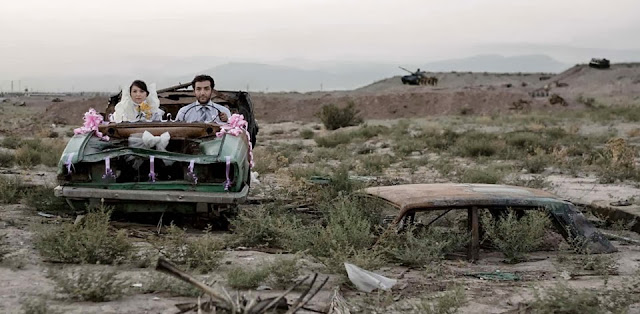 |
| Gohar Dashti, Untitled #5, From the series “Today’s Life and War” |
‘She Who Tells A Story’: is the name of an exhibition on display at the Museum of Fine Art in Boston in the USA and while few of us will have the chance to visit the exhibition, it is worth sharing some of the images.The phrase “She Who Tells a Story” comes from the word rawiya (which is also the name of a collective of female photographers working in the Middle East). But the exhibit doesn’t tell one story; it tells many. Some of the photos deal with war, but many of the images deconstruct identities and confront Orientalism.
The works are by twelve leading women photographers from Iran and the Arab world: Jananne Al-Ani, Boushra Almutawakel, Gohar Dashti, Rana El Nemr, Lalla Essaydi, Shadi Ghadirian, Tanya Habjouqa, Rula Halawani, Nermine Hammam, Rania Matar, Shirin Neshat, and Newsha Tavakolian.
These prominent photographers have tackled the very notion of representation with passion and power, questioning tradition and challenging perceptions of Middle Eastern identity. Their provocative work ranges from fine art to photojournalism and provides insights into political and social issues, including questions of personal identity and exploring the complex political and social landscapes of their home regions in images of great sophistication, expressiveness, and beauty.
The exhibition has been curated by Kristen Gresh.
“I hope that it will help people to understand the region in a better way,” Gresh said, “if not just to simply provide another perspective from what we’re hearing on the radio in the morning and seeing on television.”
Asma Khalid, writing for the website The Artery, describes the stunning entrance to the exhibition - a work by one of The View from Fez's favourite Moroccan artists, Laalla Essaydi:
As soon as you walk in the doors of the Foster Gallery at the MFA, you see Lalla Essaydi’s triptych. A woman lying on a divan is intently gazing at you. She’s gilded and glittery. Then you step closer and realize that all that glitters is not gold. It’s bullets.The woman is decorated with shell casings. She’s wearing hospital gauze with henna calligraphy tattooed all over her body.
Essaydi says the photos were a response to the revolutions that rolled through the region in 2011.
“During the time of the Arab Spring, at the beginning, I was so enchanted how women were at the forefront of everything,” Essaydi said. “And then once the [new] governments were in place, the first rule they want is to put women back again. My response to it is to use something that is so beautiful but when you think about it is really significant of violence, and violence on women to protect the domestic space,” she said.
For Essaydi, women were casualties of the Arab Spring, but rather than make that point through pictures that are painful to look at, she uses beauty to draw people in. Her sense of aesthetics has its roots in Orientalist artwork, which she says has inspired much of her photography.
“I needed to understand what makes us Arab women so different in the eyes of the West,” ~ Lalla Essaydi
Essaydi was born and raised in Morocco. She lived in Boston in the mid-1990s and graduated from the MFA’s Museum School. She says she was drawn to photography by exploring her own personal Arab identity.
“I have this love-hate relationship with the Orientalist painting,” she said. “I always thought that, you know, it’s a fantasy — it just shows these women walking around naked, doing nothing, but I had no idea people believed it was truth.”
Included in the exhibition is a work by Rania Matar from a series called “A Girl and Her Room;” the collection includes pictures of teenage girls in the Northeast juxtaposed against photos of girls in the Middle East, all in their bedrooms. (The MFA show only includes her photos from the Arab world; you can see how all the photos look side-by-side at her website.) Rania Matar grew up in Lebanon and now lives in Brookline.
Asma Khalid writes that identity is central to most of the photography in this exhibition, and that identity inevitably comes in the form of the hijab (the Islamic head scarf) or the niqab (the face veil).
One artist — Bushra Almutawakel, from Yemen — simultaneously defends and critiques the veil in her work. She has a series called “Mother, Daughter, Doll,” which is comprised of nine images of herself, her daughter and her doll. They look like studio portraits.
 |
| "Mother, Daughter, Doll" — Bushra Almutawakel |
“Coming from Yemen, that’s normally how I dress — the first photo, a coat and a scarf,” Almutawakel explained.
Her clothes are colorful, her daughter’s hair is uncovered; they’re smiling. In each passing photo, their smiles fade and they’re veiled under more layers of clothing. The final photo is entirely black.
“One of the things that I noticed over the past 10 years, there’s an extreme type of Islam that you see more and more prevalent throughout Yemen,” Almutawkel said. “And, one of the ways that you see it is how women are covered. It didn’t make sense to me, and I felt it had nothing to do with Islam.”
She says the images are a critique of her society.
“You want to fix something or change something, you’ve got to at least talk about it, or at least acknowledge that it exists,” Almutawakel said.
Details
She Who Tells a Story
Women Photographers from Iran and the Arab World
Museum of Fine Arts Boston
August 27, 2013 - January 12, 2014
Henry and Lois Foster Gallery (Gallery 158)
SHARE THIS!




No comments:
Post a Comment